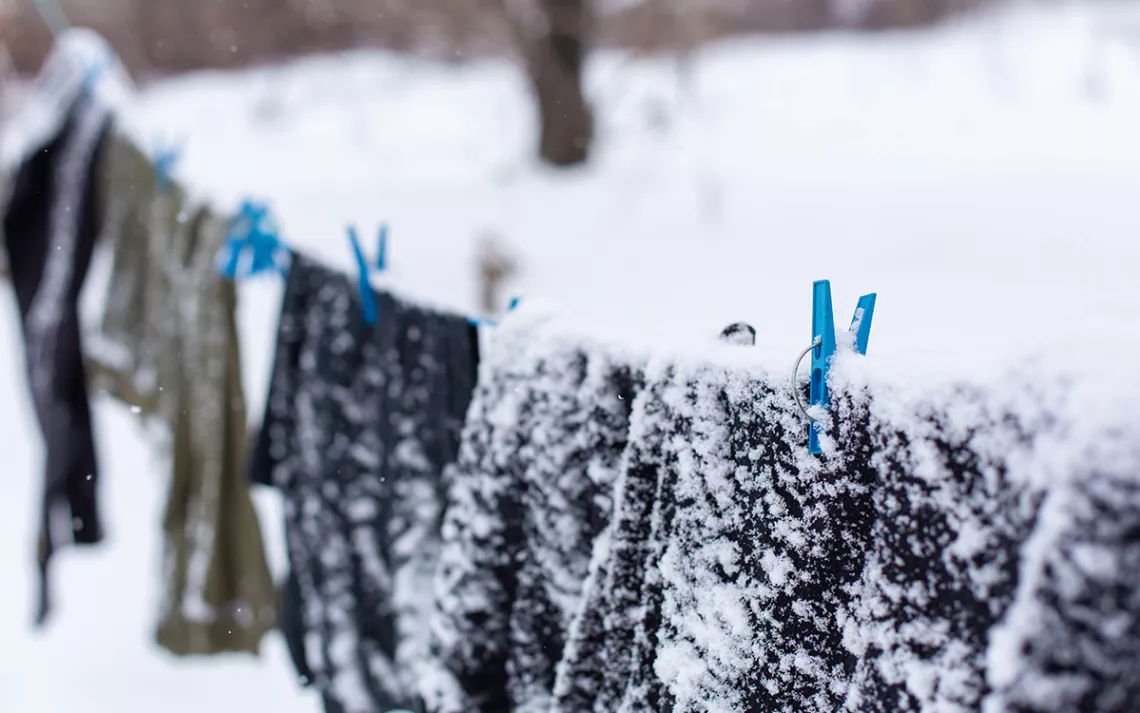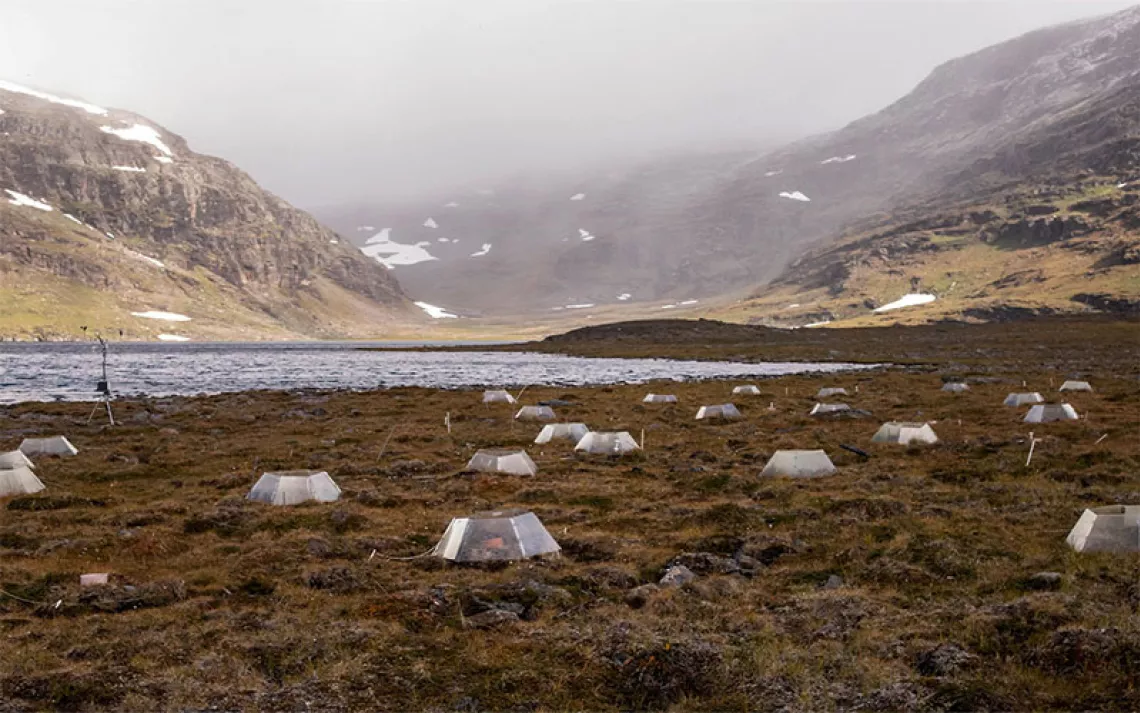Yes, You Can Line-Dry Clothes in the Dead of Winter
The science of letting your chonies freeze

Snow-covered clothes on a clothesline. | Photo by Kateryna Kukota/iStock
During my first winter in my small Vermont village, a generous neighbor approached me to ask if I wanted her old clothes dryer. I knew immediately what inspired her kindness. The day before, she’d seen me trudging through snow to the clothesline I’d strung up between two trees in my backyard, where I hung my sodden clothing and left it there to freeze solid.
Why? Winter line-drying began as an experiment a few years back, when I was curious to see if it worked (it does.) It became a habit because it costs less money and uses less electricity, but there’s something else too: I love how drying clothes in frigid temperatures lets me wield the power of sublimation, a process by which water turns directly from solid to gas, bypassing the liquid phase altogether. “You get water vapor from ice without melting it,” explained Marcus Hultmark, a professor of mechanical and aerospace engineering at Princeton University, adding that the same thing happens when ice cubes dwindle away in the freezer, as they gradually sublimate into water vapor. “It’s really sort of annoying, right?” said Hultmark, of the ice cube disappearing act. “When you need them, it’s only a handful!”
When it’s used to preserve food, sublimation is called freeze-drying, a method employed for everything from astronaut ice cream to emergency rations to a traditional Andean potato product called chuño. I saw the last process in action once while backpacking Bolivia’s Cordillera Real. I walked through hills covered with whole fresh potatoes, scattered on the bare ground until the water in them sublimated away, leaving a desiccated substance that can last for decades—basically Aymara astronaut food.
Whether you’re freeze-drying food or doing the wash, you’ll get the best sublimation in dry conditions with a bit of wind to whisk away emerging water vapor. But even in perfect weather, my freeze-dried clothes come back into the house feeling a bit stiff. On one recent day, I tweeted about my wintertime laundry habits, and a few people chimed in to say the secret to avoiding that stiffness is vinegar, a piece of old-timey wisdom that sent me down a rabbit hole of laundry science.
There are a couple of different things that result in crunchy line-dried clothing, explained Karen K. Leonas, a professor of textile sciences at North Carolina State University’s Wilson College of Textiles. Clean clothes often emerge from the washing machine with a residue of detergent or fabric softener still clinging to their fibers. “When line-drying, it forms this coating that makes it feel stiff,” Leonas said. “When you tumble dry, there’s still that residue, but it gets broken up by the mechanical action.”
That residue buildup can be the result of using too much soap, Leonas said—an increasingly common issue as detergents have gotten more powerful in recent decades. Check the instructions and measure carefully, particularly if you have a newer, high-efficiency washing machine that requires less water and less soap, and the problem may go away. Adding a half cup of vinegar toward the end of the wash cycle can also help, because the acetic acid it contains is effective at cutting through chemical residue.
Another crunch-culprit lies within the chemical makeup of the fabric itself. Turn a microscope on cotton, linen, rayon, and other cellulose-containing textiles and you’ll see that each fiber contains hundreds of thousands of polymer chains that can form hydrogen bonds as clothing dries. Lots of those bonds translate to stiff fabric. The dryer, meanwhile, keeps things moving and inhibits bond formation. “You can’t really form these bonds unless the fibers are aligned with each other,” Leonas said. “In the dryer, you’re causing this constant movement where the chains may or may not be easily aligned.”
That type of stiffness can be fixed, said Leonas, by hanging your day’s outfit in the bathroom as you shower, since introducing a little water in the form of steam can relax stiff clothing. It can also be treated by bringing in your laundry when it’s still a bit damp, finishing the process—and breaking up hydrogen bonds—with a few minutes of tumble drying.
Despite my neighbor’s concerns, my house does actually have a dryer. But I also know that tumble dryers like mine account for some 75 percent of laundry’s carbon footprint, according to the Sustainable Laundry Practices project at Colorado State University. The project also found that putting clothes in the dryer accounts for 6 percent of the average home’s overall electricity use (a number with growing impact on budgets as electricity costs are projected to keep rising in 2023).
Drying clothes outside year-round also makes a difference to my pocketbook, by increasing the longevity of my clothing, since threadbare clothes are the result of abrasion from daily wear and laundering. Dryers supercharge that wear and tear so clothes end up in the trash more quickly, adding to fast fashion’s twinned humanitarian and environmental crises. “In the dryer, you’re increasing the amount of abrasion dramatically,” Leonas said. “Reduction of the abrasion is going to increase the life of the product.”
I enjoy the environmental and financial benefits of line-drying clothes in part because I live in a so-called Right to Dry state—one whose state laws allowing outdoor drying overrule any landlords or HOAs hoping to meddle in residents’ laundry habits. The concept of a “right to dry” would have seemed comical to Americans just a couple of generations ago, when clotheslines were ubiquitous across the country. In 1980, fewer than half of US households had tumble dryers, but by 2011, that number had climbed to nearly 80 percent.
It took decades for Americans to abandon clotheslines in favor of expensive, energy-intensive appliances. It takes a lot less time to go in the opposite direction. If you have access to a yard, patio, or some indoor space to fit a fold-up drying rack, reversing the trend could begin with your next load of wash.
 The Magazine of The Sierra Club
The Magazine of The Sierra Club



